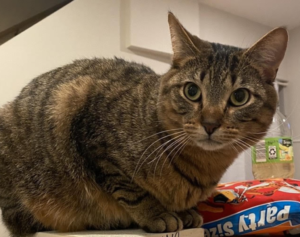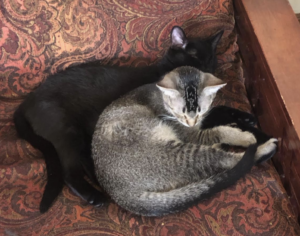For Lost Cats or Cats in Danger



Have a lost kitty?
Here are some tips:
Put familiar bowls with dry food and water, blankets, beds or toys outside of the door where the cat likely exited
Monitor the area with a motion-capture or live feed camera, if possible.
Put up flyers, with a photo included, around the cat’s neighborhood within a 4-6 block area.
Talk with neighbors and ask if they have seen any free-roaming cats; show a photo.
Post on Nextdoor, community websites and PawBoost as well as Lost/Found Pets MN.
Borrow a live trap and follow the practices on this page.
If you need to borrow a live trap, contact outreach@felinerescue.org or leave a message: (651) 760-8739 Traps are on loan, to be signed out in the black folder on the window ledge in the Feline Rescue entryway. Traps must be returned clean and empty.
The Do’s & Don’ts of Trapping
DO:
Check the trap every 15 minutes in hot, freezing or inclement weather.
Cover the back half with a lightweight tarp (when rain is possible) or a sheet (sun protection); cats are more likely to enter if it looks like a tunnel.
Trap in the evening, starting at dusk when cats are most active.
Bait the live trap with rotisserie chicken in a dish, with Silvervine powder leading into the trap. Silvervine can be found online; it is similar to catnip in effect but is much more powerful.
Watch how to set a Havahart trap: https://www.youtube.com/watch?v=BsPj6xvAfjs
Please provide plenty of fresh water using a squeeze bottle to put water into the food dish once the cat is trapped, until transport to the desired location.
Place an old towel or wee pad under the trap until the cat can be checked for a microchip, released to the owner or brought to a spay/neuter appointment.
DO NOT live trap a cat unless these resources are in place:
1. A secured intake appointment for the cat (shelter or rescue intake or spay/neuter/return) within 1 day.
2. A safe, temperature-comfortable place for the cat to go immediately after trapping. A spare bathroom, bedroom or garage can work for temporarily holding a cat.
3. The ability to monitor the live trap around the clock and check it personally every hour (15 minutes in extreme weather); live-feed cameras are highly encouraged.
4. A lightweight, waterproof tarp to protect the trap from rain/snow or a cotton sheet for sun protection until the cat can be relocated to a sheltered holding area.
5. A food and water bowl inside the trap. Wee pads or old towels under the trap.
6. A plan for checking the cat for a microchip (if the cat is socialized) at any local vet for free if the owner has not been located.
7. The resources to care for the cat properly: dry cat food, fresh water and a litter box until transfer.
IMPORTANT NOTES:
1. Be aware of the possibility of nursing kittens with a trapped female cat. Look for signs of lactation/swollen mammary glands and return her immediately to the general area to look/listen for the kittens. Kittens cannot go without nursing for long periods of time under the age of 6 weeks. Release the cat if needed and re-trap in a 6-8 weeks after the kittens are weaned/able to eat kitten wet food independently.
2. Rescues and shelters do NOT intake healthy community cats or cats that can not be picked up. DO NOT bring these cats to a shelter or animal control. It is better to return a community cat to its neighborhood or location of origin once it is spayed/neutered.
3. Be aware of the physical possibility of fleas, worms, ear mites and vomiting or diarrhea in trapped cats. Take precautions by using bite-proof Kevlar gloves/sleeves and/or heavy duty gloves if handling an unknown cat, especially if it is showing signs of fear or aggression.
How to Determine When A Cat is in Danger
A healthy cat used to living outdoors that is able to find food and shelter has no need to come indoors. The best approach to an unknown healthy cat that walks up to you is to leave it alone. It is more likely to find its way back home if you leave it where it is than if you take it home or to animal control. However, some outdoor cats do need your help.
Signs that a cat outdoors needs assistance:
1. The cat may have a disheveled appearance due an unaccustomed life on the street: it does not have time to care for itself because it is struggling to find food.
2. The cat is partially or fully declawed, visually impaired, or deaf. These cats have difficulty catching prey, and/or are at greater risk of becoming the prey of other animals.
3. The cat has a microchip. Any local vet will check a cat for a microchip free of charge. A microchip indicates that the cat has/had an owner.
4. Someone witnessed the cat being abandoned by its owner or set outside during an eviction. Many owners with financial difficulties are facing the decision of abandonment vs. euthanasia when they lose their housing.
5. The cat is injured or ill.
6. The location where the cat was found is not safe for a cat to be outdoors.
7. The cat is a kitten under 3 months/3 lbs. and is without a mother, other adult cat, or human caring for it.
A cat meeting any of these conditions should be brought to your local animal control. If your local animal control will not take it, then please contact your mayor (Minneapolis & St Paul) or local representative to request more funding for your animal control and then contact area rescues. Expect a 2-4 week delay to get into an area rescue. Please provide dry food, fresh water, a litter box and comfortable shelter in the meantime. A spare bedroom, bathroom or garage space can work for temporary holding.
Keep in mind that a lost indoor cat can be skittish and fearful in an outdoor environment but is typically able to be petted or picked up and/or may approach humans for food or assistance. It may physically present with relaxed whiskers, ears forward and tail up. Vocally, the cat may meow, purr, chirrup or trill. It will be most visible during the day. Do not attempt to approach a well-groomed cat with flat ears, aggression, enlarged and/or averted eye pupils, lowered/flattened body and either a puffed up or tucked in tail: these cats do not want your assistance.
If the cat is outdoors and not ear-tipped to indicate Trap-Neuter-Return (TNR), it is likely in need of TNR. Please make a Community Cat appointment at the Animal Humane Society. Note: hissing is a fear response and growling is a warning; both are possible with any cat. Also note that any cat is capable of biting you. A cat bite is generally a deep puncture wound that requires antibiotics to combat infection. The best preventative measure is kevlar gloves, with firm but gentle control of the head and body of the cat.
If this does not address your situation and you require further assistance, please send an email to outreach@felinerescue.org
For intake of a cat in danger, look here:
Post a found or missing cat on these pages:
Low-cost spay/neuter:
Additional assistance from field rescuers:
IMPORTANT WHEN REPORTING A CAT IN NEED OF RESCUE: include your location (address/city), number of cats (approximate), ages/genders of cats (if known), physical descriptions (health) and any photos when requesting help on these pages.
Contact outreach@felinerescue.org for a live trap or heated water dish loan for strays and community cat colonies. We also offer winter cooler shelters for cats free of charge. MNSNAP and the AHS also have live traps available for short-term loan use.
Phone: 612-900-2757
Email: info@FelineRescue.org
St. Paul, MN 55104
